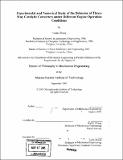Experimental and numerical study of the behavior of three-way catalytic converters under different engine operation conditions
Author(s)
Zhang, Yuetao
DownloadFull printable version (23.98Mb)
Other Contributors
Massachusetts Institute of Technology. Dept. of Mechanical Engineering.
Advisor
Wai K. Cheng.
Terms of use
Metadata
Show full item recordAbstract
The thesis reports the studies on how the three-way catalytic converters behave under different operation conditions. The main focus of the work is in the oxygen storage capacity of the three-way catalyst. Rich-to-lean air/fuel ratio step-change experiments were carried out to quantify the oxygen storage capacity. Results show that the amount of oxygen stored is dependent on how much oxygen is present in the exhaust. Thus the oxygen storage capacity is not a fixed value, rather it is determined by the equilibrium between the storage sites and the feed stream. A numerical model was developed to characterize the oxygen storage capacity. The model matches well with the experiments. The effects of catalyst age and fuel sulfur content on oxygen storage were measured. The results show that the aging effects and fuel sulfur effects are decoupled. The storage capacity decreases by 10% for every 150ppm increase in fuel sulfur, and it scales with (age⁻⁰̇⁸⁴). Different modes of air/fuel ratio modulations were tested on the catalysts, since such modulation is the practice to keep conversion efficiency high and to increase robustness of the catalyst during transients. (cont.) The results show that within a certain range, the tail-pipe NO emission is not sensitive to the variations in frequency and amplitude. When the modulation is biased towards lean, NO will eventually breakthrough when the oxygen storage capacity saturates. The observed saturation point matches well with the oxygen storage capacity observed in the air/fuel lean step experiments. A flow reactor is set up for controlled studies on catalytic actions. Results show that at typical steady state catalyst temperatures the pollutants removal rate is limited by the mass transfer speed of the slowest diffusing species in the exhaust. The experiments quantify the aging effects on conversion efficiency degradation. Results show that the front part of a catalyst loses its effectiveness exponentially with aging. The loss of effectiveness is not uniform along the catalyst; the degradation is less severe towards the back of the catalyst. A comprehensive practical model was developed based on previous works and the experiments of this project. The model takes into account oxygen storage capacity and aging effects. The comparison of the model with experiments shows good agreement.
Description
Thesis (Ph. D.)--Massachusetts Institute of Technology, Dept. of Mechanical Engineering, 2005. Includes bibliographical references (p. 231-236).
Date issued
2005Department
Massachusetts Institute of Technology. Department of Mechanical EngineeringPublisher
Massachusetts Institute of Technology
Keywords
Mechanical Engineering.